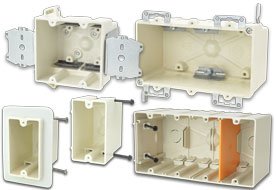Whether you’re building a new house or doing some light remodeling (or anything in between), you are the person who owns the building. That means that you are responsible for decisions that will impact the quality of construction.
With that responsibility comes countless choices that can impact building safety, regulatory compliance, and the cost of the project. It’s easy to feel overwhelmed if you’re new to this, but a handful of quick lessons can help you learn what you most need to know in order to help your project go well.
One such lesson involves electrical boxes. If your construction involves wiring, then there are some things about electrical boxes that you need to know.
Electrical Boxes Are Required
The first thing every homeowner needs to know about electrical boxes is that they are explicitly included in building codes. The exact details of any building code will vary by state, and there are even county and local regulations to consider.
Despite that, every building code has requirements regarding electrical boxes. They must be present for electrical junctions inside residential buildings. Junctions are where different electric lines are combined, which would include every light switch, outlet, ceiling fan, and other points where you can install or control electronic devices in the home.
All Things Considered, They’re Fairly Simple
Even though electrical boxes are critical for wiring safety, they’re not overly complicated devices. In principle, they exist to protect joints in the wiring. This protection prevents shorts and breaks in the wires, and by doing this, the boxes also serve to prevent electrical fires in the home.
As long as you use the boxes as intended, they work very well, and you don’t really need to worry about them. They will protect the wiring joints from generic forces and normal wear and tear. That alone is enough to prevent the joints from separating, which is how the boxes shield you from shorts, breaks, and electrical fires.
There Are a Lot of Options
There are specialized electrical boxes for just about any function you could need. Light switch and outlet boxes look a lot alike, but if you want a dual switch for a ceiling fan and light fixture, you can get a multi-gang box for that purpose.
There are countless other options like that to make wiring that much easier. You can also choose from different materials. Metals, plastics, and fiberglass are common material choices for electrical boxes, depending on the intended use.
Fortunately, for most residential use, the box doesn’t have to be super precise. You just need your boxes to be the right size and shape to accommodate the space available (although optimizing the material goes a long way toward saving money).
More importantly, if you’re not exactly sure what you need, you can ask. You can work with your contractor, electrician, or box manufacturer to explore specifics and get the right box for the job.
As long as you are aware of the abundance of options, there are enough resources to help you make a good selection.

